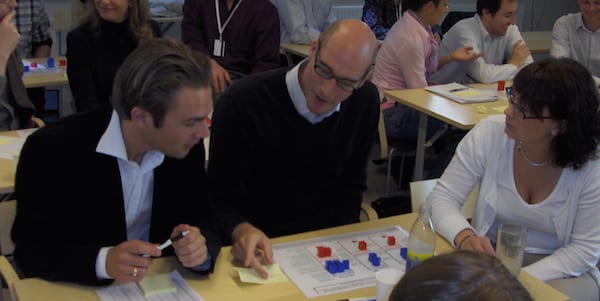
How to use games to teach lean management principles
FEATURE – Games can help you to engage people and communicate lean management principles. Here is a number of useful tips and suggestions on how to make training more… playful.
Words: Joakim Hillberg, Revere AB
My 23 years of experience as a lean consultant have taught me that the value I bring to my customers lies in helping them to build their capabilities. Since the beginning of my career, I have seen how beneficial games and simulations can be to this end, as tools people can use for experiential learning. They are much more powerful than the all too popular PowerPoint slides anyway!
Over time, I have tested a multitude of games (and even designed my own) and trained several hundreds of lean facilitators in using them – I like to think that has given me some knowledge of what makes a great lean game.
Games use multiple communication means and create engagement. More importantly, they help people to memorize concepts and allow for a more practical experience of lean than traditional teaching methods do. They give participants a chance to practice lean in a risk-free and fun environment, and work in all cultures and at all management levels.
I’ve found that the biggest benefit of using games comes in a) knowledge creation, especially in higher education (games give students a chance to experience a reality they usually have no access to - I remember one student who said that the games were “the best learning experience in my Masters”) and b) a lean transformation, either to get started and do team building (by sharing a common experience and reference - I’ve had clients still talking about the game they did at the beginning of the lean journey, years before) or to provide an input to design a future state (in this instance, games work particularly well in conjunction with a lean event such as value stream mapping exercise).
Games should not be used on their own: you need to have the next steps already planned out or the exercise will turn out to be wasteful and maybe even detrimental. After all, any form of training creates an expectation that must be met. If it isn’t, it will be harder to get people to be involved in the next initiative. Here’s an example of good practice: a client used a lean game to set up training and kick-off the use of visual boards and continuous improvement in the teams, and it worked wonderfully.
But make no mistakes: the number one criteria for success in game training is the facilitator. I’ve trained several hundreds of them and I always try to pass to them the following suggestions:
- Do not provide solutions;
- Ask questions to encourage learning;
- Ask questions to stimulate emotions;
- Impart specific lean knowledge, preferably “pulled” by the team that is playing a game, i.e. do not lecture before things happen in the game. Let the team implement pull and then discuss the difference between pull and push;
- Remember that even though it’s not your first time, it is theirs. It’s easy as a facilitator to forget this and go too fast;
- Make sure that rules are followed and that nobody cheats. Senior management in particular can get very competitive and have a tendency to take shortcuts;
- Most importantly, translate learnings from the game into takeaways on the real situation by asking questions to the team and using real lean examples. This also means that a good facilitator should be experienced in lean, of course.
Those of you who are in the process of choosing - or even designing - a lean game should also make sure they are not coming up with one that is controlled: many games I’ve come across are prescriptive and see the facilitator (or should I say dictator?) tell the group what to do. If the game is too controlled, you will not engage people and the learning will be limited. Well-designed games allow for experiential learning, instead: people are free to learn by doing, divergent pathways are possible, and the team can safely explore and fail.
Fun is also a great feature of games, as laughter relaxes the team while increasing their level of learning. In the same way, having two teams playing in parallel can be a great way to get people focused, as positive competition often creates good learning dynamics. Remember it is the conversations within the team that are important, not the game itself – playing should inspire rich conversations and enable training and learning. Great games also have several built-in feedback loops (PDCA) with clear measurements, through which the team reflects on what has happened and on the next steps.
As ever, you will not go far without reflecting on what you have learned.
Therefore, you should always make sure there is enough time to reflect on the lessons learned during the game and afterwards, on what happened in the room but also on people’s work through a set of questions. Students might find this more difficult than practitioners, but they can work with case studies or what they saw while visiting organizations.
Ultimately, the purpose of a lean game is not to simulate reality but to teach people - I’ve used service games in manufacturing with great success, because the focus of the game remained facilitating lean thinking and increasing people’s understanding.
As with everything, there are some risks inherent to games, too. The biggest one is to think that they will magically make people lean, whereas games are just a powerful tool that we can use in a lean transformation but that, alone, cannot change the way of working (our real goal). That requires a much bigger effort, and the commitment and involvement of leadership.
At the end of the day, the best game you can have people play is on-the-job training, where the real challenges of an organization are addressed using lean management principles.
THE AUTHOR

Read more


FEATURE – When you are hiring 20-30 people in a week, getting them up to speed with the company’s way of working becomes critical. But how to do it effectively? A Polish factory found the answer in TWI.


FEATURE – To consistently identify new and better ways of doing things can breathe new life into a lean journey, but only if the knowledge developed can be effectively shared across the organization.


WOMACK'S YOKOTEN – Small firms represent the backbone of the economy, and there is no doubt lean can help them improve and grow – by making the jobs they offer great. Without it, countries won't be great either.


NEWS - Back from his annual trip to Shanghai, Anton Grütter, CEO of the Lean Institute Africa, shares a few interesting insights into the Chinese culture.

